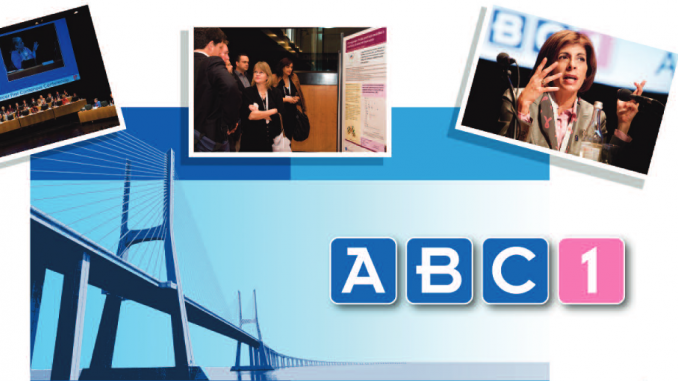
Patient advocates and professionals alike believe these groundbreaking guidelines will raise standards of care, give much-needed structure to clinical research and improve awareness about a group of patients whose needs have been neglected for too long.
At about 1pm on 5 November 2011 – just after the scheduled end of the ABC1 (Advanced Breast Cancer) conference in Lisbon, organised by the European School of Oncology (ESO) – history was made when a large multidisciplinary panel composed of experts from 15 countries completed its voting on the first global recommendations for the treatment and care of women and men with metastatic breast cancer.
For the first time, oncologists caring for patients with advanced disease have a set of evidence-based international consensus recommendations that can guide their decision-making. Patients who want to understand their treatment options and make informed choices have a document they can refer to that represents the optimal management of this disease, and are applicable almost anywhere in the world. And the prospects for improving results for patients with metastatic breast cancer have taken a leap forward now that there is an agreed standard of care providing a benchmark against which alternative management strategies can be compared, introducing some structure to a field of clinical research that has been chaotic for so long.
The panel voted on more than 50 guideline statements that will be edited, confirmed and presented early this year in a special paper in The Breast, covering all aspects of advanced breast cancer, from psychosocial care to chemotherapy and targeted agents, to treatment of specific sites of metastases.
Some statements about chemotherapy could not be agreed at the time – and others were far from unanimous – which was expected given the uncertainty and lack of evidence in a number of areas. Indeed, the need for much more research is a theme underpinning the new consensus and was much discussed at the conference. But given that this was the first international meeting of its type, a major goal was achieved with agreement on a wide range of recommendations that will now set a benchmark for a patient community that has long been suffering from inconsistent treatment and lack of support.
Six Years in the Making
These recommendations, which are summarised on pages 28 and 29, were not the work of a few experts, cooked up over a period of weeks or months. They mark a stage in an inclusive process that started many years ago. Fatima Cardoso, one of the four senior breast oncologists coordinating ABC1, who heads the breast unit at the Champalimaud Cancer Centre in Lisbon, opened the conference with a look back at the preparatory work that led up to the event, which started with the formation of the international metastatic breast cancer taskforce by ESO in 2005. This taskforce put forward initial recommendations and proposals, which were published in The Breast and the Journal of the National Cancer Institute, and were put up for discussion in well-attended sessions during the last three European Breast Cancer Conferences. The process culminated in this ABC1 conference, where an international consensus group met to vote on a full, updated set of statements, in a similar way to the St Gallen meeting for early-stage breast cancer.
More than six years since the start of this long process, Cardoso had a very clear message for the assembled delegates: “It’s time to change. It’s time for treatment of metastatic breast cancer to follow guidelines – an approach that has done so much to improve results in early disease – and it’s time to tackle the lack of psychosocial support for women and men.
“The same high-quality principles used in the early-stage setting should apply,” she said, with all women and men with advanced disease seen by a multidisciplinary team in a specialised breast unit, with each subtype of metastatic breast cancer treated differently and according to evidence, with many more patients in high-quality trials. At present, she added, in the majority of oncology departments even in the developed world, patients with advanced cancer are often cared for by individual physicians, outside a multidisciplinary team.
Cardoso’s message on the need for urgent change was strongly supported by the results of a survey carried out among the breast cancer community in the run up to ABC1. More than 80% of respondents agreed that advanced breast cancer does not have the high profile of early disease, and they listed the lack of clear and applicable management guidelines and the lack of high-level evidence for treatment options as the main reasons why.
These guidelines are key, says Cardoso, because they not only represent an international consensus based on available evidence, but they also help to provide the setting to raise standards everywhere, with greater consistency in training and care, and to identify areas of research priorities that need more funding and resources to optimise the management of this disease.
ABC1 can claim to offer a strong base for building such an international consensus, she said, because it was led by joint US-European coordinators, and the consensus panel included representatives from nursing, psycho-oncology and patient advocacy alongside top oncologists from several disciplines and a wide variety of countries covering four continents.
Leading it all, alongside Cardoso, were two top American breast medical oncologists, Larry Norton from Memorial Sloan-Kettering and Eric Winer from the Dana-Farber Cancer Institute, together with Alberto Costa, a senior breast surgeon and director of ESO, who helped ensure the presence of many of the world’s leading specialists to present the state of the art for research and treatment. And there was no holding back on the highly complex science underlying the huge challenge of improving outcomes.
Guidelines Help Informed Choices
But this conference kept a clear focus on patients, so it was Musa Mayer, a patient advocate who runs AdvancedBC.org, a patient support site, who gave the keynote talk. Mayer spoke of her experience as a survivor of early breast cancer, of how she met many fellow patients who later died from advanced disease, and of how little information and support there had been. “Women and men living with metastatic disease have been largely invisible and unheard – at no time is this more apparent than in October when we in the US are awash with pink ribbons and upbeat messages about early detection and survivorship,” she said. “Patients with metastatic disease often feel unwelcome, representing as they do a feared outcome for those with primary breast cancer.”
“Patients with metastatic disease often feel unwelcome, representing as they do a feared outcome”
Now there are support groups for those with advanced cancer, she added, noting that several had posters at the conference. As more people are living longer, thanks to new treatments, their day-to-day concerns take on new urgency, said Mayer. How do you manage the effects of treatment and cancer progression, or the impact of treatment failure, and the loss of function and place in the community? “These take a heavy toll,” she said, adding that it is difficult to plan and fund services for this group of patients because there are no reliable statistics on how many have advanced cancer and where they are. “We lack an accurate count of this population in the US as distant recurrences are not captured by cancer registries.”
It’s time for patients with advanced disease to be counted and made a public health priority, said Mayer, who also called for better funding for research on metastases, and a rethink of clinical trials, particularly regarding the choice of endpoints for efficacy, and full integration of quality-of-life measures, for example using patient-reported outcomes.
“If the confusion patients face in making treatment decisions can be reduced, and meaningful guidelines can be crafted that account for individual differences and respect patient preferences, it will help women and men with metastatic breast cancer manage the anxiety and loss of confidence they feel when a treatment fails,” she said, adding, “ABC1 is a crucial first step and patients and advocates are watching and grateful that our time has finally come.”
“ABC1 is a crucial first step and patients and advocates are watching and grateful that our time has finally come”
Management of Advanced Disease
Clinical aspects of advanced breast cancer occupied the majority of the conference, from imaging developments, well summarised by Nehmat Houssami from Sydney, Australia, and pathology challenges, discussed by Giuseppe Viale, from the European Institute of Oncology, Milan, to state-of-the-art treatment of HER2-positive, triple negative and ER-positive subtypes, and treatment approaches for specific sites (bone and brain) and specific populations (older and very young patients). These presentations set out the current evidence from which the majority of the consensus statements have been developed.
HER2+ subtype
On the HER2+ subtype, for example, Cardoso set out the evidence for its management – that it is a well-identified disease and selection of patients is crucial; the targeted drugs trastuzumab and lapatinib work well; there is a good safety profile of the agents; and trastuzumab can be combined with several different chemotherapies. But brain metastases are an important problem, and resistance to therapies inevitably occurs – a topic covered in some detail by George Sledge from Indiana University, and the then ASCO president. Ian Krop from Dana-Farber looked at some of the drugs in the pipeline that might help address some of these issues.
Triple negative disease
In contrast, there are no targeted therapies approved yet for triple negative disease, which causes a disproportionate number of deaths, reported Eric Winer. The conference heard from Andrew Tutt, based at Guy’s Hospital breast unit in London, about the latest developments in PARP inhibitors, which have been the subject of much attention but also disappointment in the cancer world, and from Angelo Di Leo, Prato, Italy, on other possible targeted approaches. Despite early hopes, the anti-angiogenesis drug bevacizumab now appears to have no survival value (and indeed the FDA has withdrawn approval in the US for use in advanced breast cancer).
ER+ subtype
The much more common endocrine-responsive (ER+) category – which accounts for 75–80% of cases – was also given a thorough review. A group of top oncologists, including Bella Kaufman (Israel), Olivia Pagani (Switzerland), Nadia Harbeck (Germany) and Cliff Hudis, from Memorial Sloan-Kettering and ASCO president-elect, covered the topics of hormone therapy, the complexity of applying chemotherapy in this group, and the applicability of targeted therapies.
Managing bone and brain metastases
The conference heard too about complex management issues for bone and brain metastases, with contributions from Robert Coleman, of Sheffield, UK, and Nancy Lin of Dana-Farber. In bone, a new antibody drug, denosumab, is showing benefit.
Younger patients, older patients
Particular issues in the management of patients who are very young (below 35 years old) were also discussed. Data on optimal therapy for women aged below 35 are sparse because few develop metastatic disease. Karen Gelmon from the British Columbia Cancer Agency, Canada, said it is not known whether therapies for older women are equally applicable in those under 35 or 40, and she charted possible options, noting that there is a higher proportion of triple negative and HER2+ disease in some younger populations. There are also many social and lifestyle factors to consider with these groups, she said.
Prudence Francis, from the MacCallum Cancer Centre in Melbourne, Australia was among those who travelled furthest to ABC1. She noted the under-representation of older people in clinical trials despite the rising incidence of metastatic disease in an ageing population. She also described how comprehensive geriatric assessment can help meet good quality of life and function, and outlined the treatment strategies – some of which are underused – that are more suitable to older patients.
Treating patients in poorer countries
Nagi Saghir, from the Breast Center of Excellence in Beirut, described the growing burden of breast cancer in low- and middle-income countries, where in many it is common for women to be diagnosed with locally advanced or metastatic cancer. Much work is needed on raising awareness, improving access to drugs and to high quality palliative care, and countering the ‘brain drain’ of health workers through better local training opportunities, he said.
Guidelines Facilitate Research
Eric Winer stressed how common it is for general oncologists, and not just breast specialists, to take care of patients with advanced disease, adding to the importance of getting international guidelines agreed, disseminated and used. Yet he also argued that guidelines are not an answer in themselves. “I think sometimes people forget the purposes that guidelines serve. They do lead to better care by eliminating some variability, and especially unnecessary care. But what may be more important from my perspective is that guidelines facilitate research.”
He described three inputs into research – first, if patients are treated according to guidelines it is much easier to look back and assess how they have done, which will contribute to comparative effectiveness work. Second, a great deal is learned when professionals struggle to come up with a guideline for a given problem, as there is a lot of debate and uncertainty, and that automatically means there is a need for prospective clinical research. And finally, practising according to guidelines helps craft an overall clinical trials agenda. He called for better partnership with basic scientists, improved access to biopsy tissue and an end to the ‘intolerable’ delays caused by regulations.
The conference discussed many topics of research that may hold the key to progress in treating advanced disease.
The mechanics of metastases
The science of metastases was covered by several speakers. Primary tumours seem predisposed to invade different organs at the metastatic stage, and scientists are homing in on mechanisms and targets for the selection of say bone or lung for cancer spread, exemplified by the work of Roger Gomis from the Institute for Research in Biomedicine, Barcelona. The loss of a metastatic suppressor in certain breast cancers, for example, is one area to target; another is the Src gene that allows cancer cells to develop in the bone in a so-called ‘seed pre-selection’ mechanism.
Much of this work is made possible by analysing the gene expression signatures and single gene alterations of tumours, and Laura van ‘t Veer, a pioneer of gene signatures, described how clinicians will be able to make use of new tools to develop personalised approaches for metastatic patients.
The ‘seed–soil’ mechanism
The way tumour cells are prepared for circulation and seeding was also up for discussion. David Lyden, at Weill Cornell Medical College, presented work on exosomes – tiny particles secreted normally by bone marrow, but also by tumours, which contain information that can ‘educate’ and prepare the environment (in particular the blood vessels) for remote metastasis. Early intervention in this process could be valuable in what is a detailed development of the long-hypothesised ‘seed–soil’ mechanism. Larry Norton told the audience about ‘self-seeding’, where primary cancers are both the source and a recipient of tumour cells – which is very different from the widely held model of one-way spread to distant sites, and has now been confirmed in many experiments.
Guidelines and the quality of life
The focus then returned to the experience of patients, with discussion of issues in palliative care and balancing benefits and harms. Radiation oncologist Alan Rodger discussed the role of radiotherapy in metastatic breast cancer, noting its proven role in palliating bone and brain metastases. Patricia Ganz, from the Jonsson Comprehensive Cancer Center in Los Angeles, looked at endpoints for treatment, arguing that patient preferences must be included, particularly where therapies that have a benefit only on progression-free survival also lead to increased toxicity.
This theme was taken up by Lesley Fallowfield, an outspoken pyscho-oncologist from the UK. “We have to be very clear about the benefits and harms of the treatment we are recommending,” she said. “Patients have to make some very difficult decisions.”
“We have to be very clear about the benefits and harms of the treatment we are recommending”
Fallowfield questioned some of the research suggesting that patients will accept all sorts of toxicities for minimal benefit, arguing that much of it is flawed, and that the veracity of much of the safety and side-effect data from trials is doubtful and often does not tally with patient-reported outcomes. Quality of life experience is often “under-reported, under-recognised and undertreated”, she said, and she called for the use of better systems for capturing patient-reported outcomes, which are now available.
Patient advocacy groups will have a crucial role to play in improving the way patient experiences are reported and evaluated, thereby improving the quality of information on which future patients can base their decisions. But, as Stella Kyriakides and Bettina Borisch, past and current presidents of the European Breast Cancer Coalition, Europa Donna, both pointed out, strong patient advocacy will also be essential if the new guidelines are to have the desired impact on improving research, treatment and support. A strong political voice for advocates is needed to raise awareness about the needs of patients with advanced breast cancer, generate support for the resources to meet those needs, and ensure patients get to know about the new guidelines – and their doctors start to use them.
The ABC conference takes place every two years, alternating with the Breast Cancer in Young Women conference. ABC2 is scheduled for 7–9 November 2013, in Lisbon
Guidelines for managing patients with advanced breast cancer
General recommendations
- As management of ABC is complex it is crucial that it is carried out by a multidisciplinary team
- From diagnosis, patients should be offered routine psychosocial and symptom-related care
- The virtually incurable nature of the disease must be explained and discussed, as well as realistic treatment goals
- Patients and their families/caregivers (where appropriate) should be invited to take part in decision making
- As there are few proven standards of care, inclusion in clinical trials must be a priority whenever available
- Balanced decisions about costly treatment should be made, but patient preference, wellbeing and length of life should be the main decision factors
- Validated patient-reported outcomes provide useful information and should be integrated with clinical assessments
Assessment
- Minimal staging work-up recommendations; tumour markers can be an aid; a framework for response to therapy; safe biopsies of metastatic lesions at first diagnosis; reassessment of ER and HER2 status at least once
- The panel did not recommend routine brain imaging for HER2+ and triple negative patients
Treatment
- Endocrine therapy is the preferred option as ER+ comprises the majority of cases, with tamoxifen the endocrine agent of choice
- Treatment of men with metastatic breast cancer:
- The true value of the removal of the primary tumour in stage IV breast cancer patients is currently unknown, but it can be considered in selected patients if technically possible and only if performed optimally. There is ongoing research on this
- Two statements were made on brain metastases and appropriate surgery, radiosurgery and whole brain radiation
- A bone-modifying agent (bisphosphonate, denosumab) should be routinely used for bone metastases; radiological investigation and treatment may be needed for bone pain; spinal cord compression should be investigated according to symptoms
- Bevacizumab can be considered in highly selected cases but there are currently no predictive factors
- Sequential chemotherapy is the preferred choice; combination chemotherapy should be reserved for cases of rapid progression
- The small subset of patients who can achieve complete remission should be treated in a specific way
A range of treatment options and approaches were agreed for disease in these categories: HR+; ER+/HER2-; HER2+ and ER+/HER2+ - Age should not be a reason to withhold therapy
- Treatment choice should take into account a wide range of factors (these were detailed)
- Targeted therapies should be considered after a receptor-positive test in either the primary or metastatic tumour, as it is unknown which should be taken into account
- An aromatase inhibitor is an option for men progressing or relapsing on tamoxifen, but should be given concomitantly with an LHRH agonist
Palliative/supportive care
- Supportive care should always be part of the treatment plan
- Expert palliative care including pain control should be a priority and patients should have access to effective control of pain including morphine
- End-of-life care discussions should start earlier in the course of metastatic disease
Managing costs
The issue of cost was tackled head on by David Cameron – not the British Prime Minister but an oncologist based in Edinburgh. More money is lost to economies through cancer than other diseases, he said, so there is a case for spending more on cancer to help the financial situation. Drugs are often put forward as the major expense but are only about a fifth of cancer spend at present in countries such as France, he noted, so it is also important to look at optimising the other 80% of spend. In the US, the fastest rising costs are in imaging. “Could we also save money in how we organise healthcare?” he asked, suggesting that more people could be treated as outpatients, which may be more convenient to them, if not to health professionals. Drug costs are rising too of course, although much spend is on conventional chemotherapy as the cancer population rises and more older people receive treatment as ‘ageism’ disappears. Cameron weighed up the debate on using cost-effectiveness bodies such as England’s NICE to determine often tough decisions about what will be paid for. “We have to understand health economics so we can drive the agenda on behalf of our patients,” he said.





